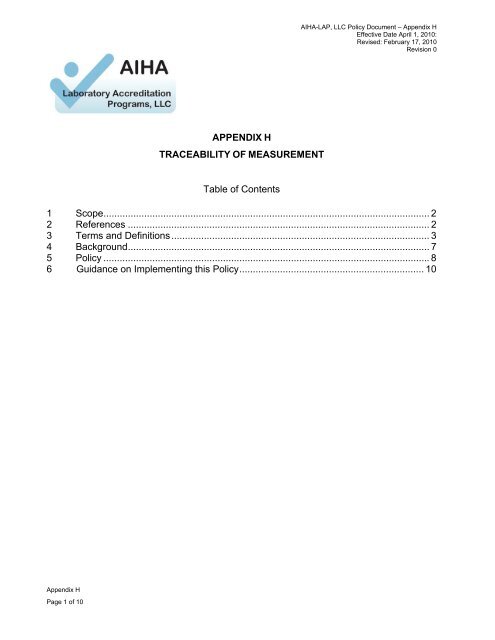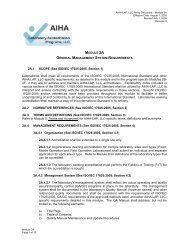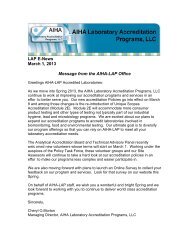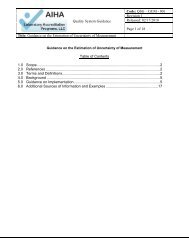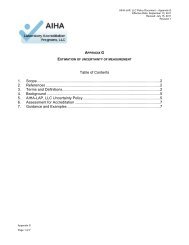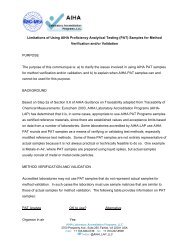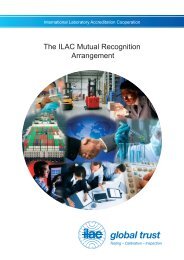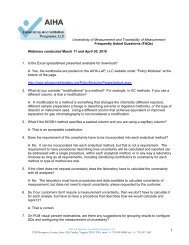APPENDIX H TRACEABILITY OF MEASUREMENT Table of ...
APPENDIX H TRACEABILITY OF MEASUREMENT Table of ...
APPENDIX H TRACEABILITY OF MEASUREMENT Table of ...
You also want an ePaper? Increase the reach of your titles
YUMPU automatically turns print PDFs into web optimized ePapers that Google loves.
AIHA-LAP, LLC Policy Document – Appendix H<br />
Effective Date April 1, 2010:<br />
Revised: February 17, 2010<br />
Revision 0<br />
<strong>APPENDIX</strong> H<br />
<strong>TRACEABILITY</strong> <strong>OF</strong> <strong>MEASUREMENT</strong><br />
<strong>Table</strong> <strong>of</strong> Contents<br />
1 Scope........................................................................................................................ 2<br />
2 References ............................................................................................................... 2<br />
3 Terms and Definitions............................................................................................... 3<br />
4 Background............................................................................................................... 7<br />
5 Policy ........................................................................................................................8<br />
6 Guidance on Implementing this Policy.................................................................... 10<br />
Appendix H<br />
Page 1 <strong>of</strong> 10
AIHA-LAP, LLC Policy Document – Appendix H<br />
Effective Date April 1, 2010:<br />
Revised: February 17, 2010<br />
Revision 0<br />
1. SCOPE<br />
This AIHA-LAP, LLC Policy documents the requirements for laboratories to maintain accreditation<br />
to ISO/IEC 17025 with regard to traceability <strong>of</strong> measurement. This policy applies to all laboratories<br />
accredited under the AIHA-LAP, LLC Laboratory Accreditation Program. AIHA-LAP, LLC wishes to<br />
thank and acknowledge the Canadian Association for Laboratory Accreditation (CALA) for its<br />
permission to incorporate elements <strong>of</strong> CALA A61 – CALA Traceability Policy in preparing this<br />
policy document.<br />
2. REFERENCES<br />
The following documents provide the basis and assist with application <strong>of</strong> the principles stated in<br />
this policy.<br />
• AIHA-LAP, LLC Policy Appendix G on the Estimation <strong>of</strong> Uncertainty <strong>of</strong><br />
Measurement<br />
http://www.aihaaccreditedlabs.org/policymodules/Documents/ApGPolicyEstimationUnce<br />
rtaintyMeasurement.pdf<br />
• CALA Traceability Policy, CALA A61 http://www.cala.ca/A61-CALA_Trac.pdf<br />
• General requirements for the competence <strong>of</strong> testing and calibration laboratories,<br />
ISO/IEC 17025:2005<br />
• Guidelines for the determination <strong>of</strong> calibration intervals <strong>of</strong> measuring equipment,<br />
ILAC G 24:2007 http://www.ilac.org/documents/ILAC_G24_2007.pdf<br />
• Guidelines for the Selection and Use <strong>of</strong> Reference Materials, ILAC G9:2005<br />
http://www.ilac.org/documents/ILAC_G9_2005_guidelines_for_the_selection_and_use_<br />
<strong>of</strong>_reference_material.pdf<br />
• ILAC Policy on the Traceability <strong>of</strong> Measurement Results, ILAC P10:2002<br />
http://www.ilac.org/documents/ILAC_P10_2002_ILAC_Policy_on_Traceability_<strong>of</strong>_Meas<br />
urement_Result.pdf<br />
• International vocabulary <strong>of</strong> metrology — Basic and general concepts and<br />
associated terms (VIM), VIM JCGM 200:2008<br />
• Metrological Traceability Of Measurement Results In Chemistry: Concepts And<br />
Implementation (IUPAC Recommendations 2009), International Union <strong>of</strong> Pure and<br />
Applied Chemistry (IUPAC), Paul De Bièvre1, René Dybkaer, Aleš Fajgelj And D. Brynn<br />
Hibbert, http://www.iupac.org/web/ins/2001-010-3-500<br />
Appendix H<br />
Page 2 <strong>of</strong> 10
AIHA-LAP, LLC Policy Document – Appendix H<br />
Effective Date April 1, 2010:<br />
Revised: February 17, 2010<br />
Revision 0<br />
3. TERMS AND DEFINITIONS<br />
Appendix H<br />
Page 3 <strong>of</strong> 10<br />
Calibration: operation that, under specified conditions, in a first step, establishes a relation<br />
between the quantity values with measurement uncertainties provided by measurement<br />
standards and corresponding indications with associated measurement uncertainties and,<br />
in a second step, use this information to establish a relation for obtaining a measurement<br />
result from an indication. (VIM 2.39 JCGM 200:2008)<br />
Certified Reference Material (CRM): reference material, accompanied by documentation<br />
issued by an authoritative body and providing one or more specified property values with<br />
associated uncertainties and traceabilities, using valid procedures. (VIM 5.14 JCGM<br />
200:2008)<br />
Critical equipment: “Critical” equipment used by testing and calibration laboratories is<br />
considered by ILAC to be those items <strong>of</strong> equipment necessary to perform a test or<br />
calibration from the scope <strong>of</strong> accreditation and which have a significant effect on the<br />
uncertainty <strong>of</strong> measurement <strong>of</strong> test or calibration results (ILAC-P10:2002). For the purposes<br />
<strong>of</strong> this policy, AIHA-LAP LLC considers any contribution that is ≥ 1/3 <strong>of</strong> the largest<br />
measurement uncertainty contributor for a test method to be a significant contributor to<br />
measurement uncertainty.<br />
Measurement Result (result <strong>of</strong> measurement): set <strong>of</strong> quantity values being attributed to a<br />
measurand together with any other available relevant information. (VIM 2.9 JCGM<br />
200:2008)<br />
Measurement Standard: realization <strong>of</strong> the definition <strong>of</strong> a given quantity, with stated<br />
quantity value and associated measurement uncertainty, used as a reference (VIM 5.1<br />
JCGM 200:2008) The following are examples and notes presented in the VIM (as<br />
numbered) that are relevant to the measurements performed by AIHA-LAP, LLC<br />
laboratories:<br />
EXAMPLE 1 1 kg mass measurement standard with an associated standard<br />
measurement uncertainty <strong>of</strong> 3 μg.<br />
EXAMPLE 4 Hydrogen reference electrode with an assigned quantity value <strong>of</strong> 7.072<br />
and an associated standard measurement uncertainty <strong>of</strong> 0.006.<br />
EXAMPLE 6 Reference material providing quantity values with measurement<br />
uncertainties for the mass concentration <strong>of</strong> each <strong>of</strong> ten different proteins.<br />
NOTE 2: A measurement standard is frequently used as a reference in establishing<br />
measured quantity values and associated measurement uncertainties for other<br />
quantities <strong>of</strong> the same kind, thereby establishing metrological traceability through<br />
calibration <strong>of</strong> other measurement standards, measuring instruments, or measuring<br />
systems.<br />
NOTE 5: Quantity value and measurement uncertainty must be determined at the time
AIHA-LAP, LLC Policy Document – Appendix H<br />
Effective Date April 1, 2010:<br />
Revised: February 17, 2010<br />
Revision 0<br />
when the measurement standard is used.<br />
Measuring System: set <strong>of</strong> one or more measuring instruments and <strong>of</strong>ten other devices,<br />
including any reagent and supply, assembled and adapted to give information used to<br />
generate measured quantity values within specified intervals for quantities <strong>of</strong> specified<br />
kinds (VIM 3.2 JCGM 200:2008)<br />
NOTE: A measuring system may consist <strong>of</strong> only one measuring instrument.<br />
Measurement Uncertainty (uncertainty <strong>of</strong> measurement) (uncertainty): non-negative<br />
parameter characterizing the dispersion <strong>of</strong> the quantity values being attributed to a<br />
measurand, based on the information used (VIM 2.26 JCGM 200:2008)<br />
Metrological Traceability (traceability): property <strong>of</strong> a measurement result whereby the<br />
result can be related to a reference through a documented unbroken chain <strong>of</strong> calibrations,<br />
each contributing to the measurement uncertainty (VIM 2.41 JCGM 200:2008)<br />
NOTE 1 For this definition, a ‘reference’ can be a definition <strong>of</strong> a measurement unit through its practical<br />
realization, or a measurement procedure including the measurement unit for a non-ordinal quantity, or a<br />
measurement standard.<br />
NOTE 2 Metrological traceability requires an established calibration hierarchy.<br />
NOTE 3 Specification <strong>of</strong> the reference must include the time at which this reference was used in establishing<br />
the calibration hierarchy, along with any other relevant metrological information about the reference, such as<br />
when the first calibration in the calibration hierarchy was performed.<br />
NOTE 4 For measurements with more than one input quantity in the measurement model, each <strong>of</strong> the input<br />
quantity values should itself be metrologically traceable and the calibration hierarchy involved may form a<br />
branched structure or a network. The effort involved in establishing metrological traceability for each input<br />
quantity value should be commensurate with its relative contribution to the measurement result.<br />
NOTE 5 Metrological traceability <strong>of</strong> a measurement result does not ensure that the measurement uncertainty is<br />
adequate for a given purpose or that there is an absence <strong>of</strong> mistakes.<br />
NOTE 6 A comparison between two measurement standards may be viewed as a calibration if the comparison<br />
is used to check and, if necessary, correct the quantity value and measurement uncertainty attributed to one <strong>of</strong><br />
the measurement standards.<br />
NOTE 7 The ILAC considers the elements for confirming metrological traceability to be an unbroken<br />
metrological traceability chain to an international measurement standard or a national measurement<br />
standard, a documented measurement uncertainty, a documented measurement procedure, accredited<br />
technical competence, metrological traceability to the SI, and calibration intervals (see ILAC P-10:2002).<br />
NOTE 8 The abbreviated term “traceability” is sometimes used to mean ‘metrological traceability’ as well<br />
as other concepts, such as ‘sample traceability’ or ‘document traceability’ or ‘instrument traceability’ or<br />
‘material traceability’, where the history (“trace”) <strong>of</strong> an item is meant. Therefore, the full term <strong>of</strong> “metrological<br />
traceability” is preferred if there is any risk <strong>of</strong> confusion.<br />
Metrological Traceability to a measurement unit: metrological traceability where the<br />
reference is the definition <strong>of</strong> a measurement unit through its practical realization. (VIM 2.43<br />
JCGM 200:2008)<br />
NOTE: The expression “traceability to the SI” means ‘metrological traceability to a<br />
measurement unit <strong>of</strong> the International System <strong>of</strong> Units’.<br />
Appendix H<br />
Page 4 <strong>of</strong> 10
AIHA-LAP, LLC Policy Document – Appendix H<br />
Effective Date April 1, 2010:<br />
Revised: February 17, 2010<br />
Revision 0<br />
National Metrology Institute: ILAC considers an “appropriate “ national metrology<br />
institute to be one that participates regularly and successfully in relevant international<br />
interlaboratory comparisons performed by BIPM and/or by regional metrology bodies.<br />
ILAC encourages BIPM and regional bodies to conduct and publish details <strong>of</strong> as broad a<br />
range <strong>of</strong> international comparisons as possible to provide transparency on the<br />
equivalence and linkages <strong>of</strong> national measurement standards, which underpin<br />
accreditation activities. ILAC has taken note that the results <strong>of</strong> international comparisons<br />
carried out in the scope <strong>of</strong> the Metre Convention are published in Appendix B <strong>of</strong> the<br />
CIPM MRA (www.bipm.org).<br />
NIST Standard Reference Material® (SRM) - A CRM issued by NIST that also meets<br />
additional NIST-specific certification criteria and is issued with a certificate or certificate <strong>of</strong><br />
analysis that reports the results <strong>of</strong> its characterizations and provides information regarding<br />
the appropriate use(s) <strong>of</strong> the material (NIST SP 260-136).<br />
Note: An SRM is prepared and used for three main purposes: (1) to help develop<br />
accurate methods <strong>of</strong> analysis; (2) to calibrate measurement systems used to facilitate<br />
exchange <strong>of</strong> goods, institute quality control, determine performance characteristics, or<br />
measure a property at the state-<strong>of</strong>-the-art limit; and (3) to ensure the long-term adequacy<br />
and integrity <strong>of</strong> measurement quality assurance programs. The terms "Standard Reference<br />
Material" and the diamond-shaped logo which contains the term "SRM," are registered with<br />
the United States Patent and Trademark Office. (NIST Definitions)<br />
Primary measurement standard (primary standard): measurement standard<br />
established using a primary reference measurement procedure, or created as an artifact,<br />
chosen by convention (VIM 5.4 JCGM 200:2008)<br />
EXAMPLE 1 Primary measurement standard <strong>of</strong> amount- <strong>of</strong>-substance concentration<br />
prepared by dissolving a known amount <strong>of</strong> substance <strong>of</strong> a chemical component to a<br />
known volume <strong>of</strong> solution<br />
EXAMPLE 3 Primary measurement standard for isotope amount-<strong>of</strong>-substance ratio<br />
measurements, prepared by mixing known amount-<strong>of</strong>-substances <strong>of</strong> specified isotopes<br />
EXAMPLE 4 Triple-point-<strong>of</strong>-water cell as a primary measurement standard <strong>of</strong><br />
thermodynamic temperature. [for temperature]<br />
EXAMPLE 5 The international prototype <strong>of</strong> the kilogram as an artifact, chosen by<br />
convention [for mass].<br />
Reference Material (RM): material, sufficiently homogeneous and stable with reference to<br />
specified properties, which has been established to be fit for its intended use in<br />
measurement or in examination <strong>of</strong> nominal properties (VIM 5.13 JCGM 200:2008) (To<br />
provide clarity for testing laboratories, AIHA-LAP, LLC uses the term reference material to<br />
be those related to chemical and microbiological references. Reference materials include<br />
neat materials, chemical solutions, and microbiologic cultures.)<br />
Appendix H<br />
Page 5 <strong>of</strong> 10
AIHA-LAP, LLC Policy Document – Appendix H<br />
Effective Date April 1, 2010:<br />
Revised: February 17, 2010<br />
Revision 0<br />
Reference Measurement Standard (reference standard): measurement standard<br />
designated for the calibration <strong>of</strong> other measurement standards for quantities <strong>of</strong> a given kind<br />
in a given organization or at a given location (VIM 5.6 JCGM 200:2008) (To provide clarity<br />
for testing laboratories, AIHA-LAP, LLC uses the term reference standard to be those<br />
related to physical attributes such as mass, length, and temperature that are defined by<br />
convention as traceable to the SI through an NMI such as NIST).<br />
Secondary Reference Standard: measurement standard established through calibration<br />
with respect to a primary measurement standard for a quantity <strong>of</strong> the same kind (VIM 5.5<br />
JCGM 200:2008)<br />
NOTE 1 Calibration may be obtained directly between a primary measurement<br />
standard and a secondary measurement standard, or involve an intermediate<br />
measuring system calibrated by the primary measurement standard and assigning a<br />
measurement result to the secondary measurement standard.<br />
NOTE 2 A measurement standard having its quantity value assigned by a ratio primary<br />
reference measurement procedure is a secondary measurement standard.<br />
SI (International System <strong>of</strong> Units): System <strong>of</strong> units. The name adopted by the 11th<br />
General Conference on Weights and Measures (1960) for the recommended practical<br />
system <strong>of</strong> units <strong>of</strong> measurement. The base units are a choice <strong>of</strong> seven well-defined units:<br />
the metre, the kilogram, the second, the ampere, the Kelvin, the mole, and the candela.<br />
Verification: provision <strong>of</strong> objective evidence that a given item fulfils specified requirements.<br />
(VIM 2.26 JCGM 200:2008)<br />
(CALA/AIHA-LAP, LLC) A procedure normally associated with the acquisition <strong>of</strong> data<br />
regarding an instrument to provide some indication as to whether it is operating within<br />
expected tolerances. For example, weights may be placed on a balance and the reading<br />
can provide some indication as to whether the balance is operating within expected<br />
tolerances. This operation should not be confused with calibration. Verification does not<br />
establish traceability. Verification seeks only to determine whether or not the instrument is<br />
operating within its expected tolerances. It is not a method <strong>of</strong> establishing the expanded<br />
uncertainty, which is the core issue in a calibration.<br />
Note that manufacturer’s tolerances, as provided in data sheets and instrument manuals,<br />
will use the same method <strong>of</strong> expression as an uncertainty, such as +/- 3% or +/- 4 grams.<br />
These are still only tolerances and should not be confused with the expanded uncertainties<br />
associated with the measurement result.<br />
Working measurement standard (working standard): measurement standard that is<br />
used routinely to calibrate or verify measuring instruments or measuring systems. (VIM 5.7<br />
JCGM 200:2008)<br />
Appendix H<br />
Page 6 <strong>of</strong> 10
AIHA-LAP, LLC Policy Document – Appendix H<br />
Effective Date April 1, 2010:<br />
Revised: February 17, 2010<br />
Revision 0<br />
4. BACKGROUND<br />
ISO/IEC 17025, section 5.6 requires conformant laboratories to demonstrate that the results<br />
produced by their measuring systems are traceable in accordance with the international definition<br />
<strong>of</strong> that term. See the definition for metrological traceability above and the International<br />
vocabulary <strong>of</strong> metrology — Basic and general concepts and associated terms (VIM) (VIM<br />
JCGM 200:2008).<br />
This allows<br />
• Laboratories to support the validity <strong>of</strong> test results.<br />
• Laboratories and users to make objective comparison <strong>of</strong> different test results.<br />
• Laboratories and users to make sound interpretation <strong>of</strong> individual test results.<br />
Traceability is characterized (in ILAC documents and the VIM) by:<br />
(a) an unbroken chain <strong>of</strong> comparisons going back to stated references acceptable to the parties,<br />
usually a national or international standard;<br />
(b) uncertainty <strong>of</strong> measurement; the uncertainty <strong>of</strong> measurement for each step in the<br />
traceability chain must be calculated or estimated according to agreed methods and must be<br />
stated so that an overall uncertainty for the whole chain may be calculated or estimated<br />
(c) documentation; each step in the traceability chain must be performed according to<br />
documented and generally acknowledged procedures; the results must be recorded;<br />
(d) competence; the laboratories or bodies performing one or more steps in the traceability chain<br />
must supply evidence for their technical competence (e.g. by demonstrating that they are<br />
accredited for that activity);<br />
(e) reference to SI units; the chain <strong>of</strong> comparisons must, where possible, end at primary<br />
standards for the realization <strong>of</strong> the SI units;<br />
(f) calibration intervals; calibrations must be repeated at appropriate intervals; the length <strong>of</strong> these<br />
intervals will depend on a number <strong>of</strong> variables (e.g. uncertainty required, frequency <strong>of</strong> use, way <strong>of</strong><br />
use, stability <strong>of</strong> the equipment).<br />
In the area <strong>of</strong> chemistry, traceability <strong>of</strong> all measurements is problematic due to recent changes in<br />
terminology, difficulties in melding <strong>of</strong> chemical concepts with metrological traceability as required<br />
by ISO/IEC 17025, and lack <strong>of</strong> reference materials from metrological organizations. The IUPAC<br />
Committee has been working towards a recommendation document addressing traceability in<br />
chemical measurements since 2001. The latest version (2009) has been reviewed to help establish<br />
the concepts presented in this document along with the other references (Section 2). The concepts<br />
used in chemistry may also be applied to microbiological measurements. As the international<br />
community in the fields <strong>of</strong> chemistry and biology continues to develop consensus statements,<br />
AIHA-LAP, LLC will adopt those that are appropriate to its scope <strong>of</strong> accreditation activities.<br />
AIHA-LAP, LLC provides this policy and associated general guidance on acceptable and<br />
appropriate methods for accredited laboratories to:<br />
Appendix H<br />
Page 7 <strong>of</strong> 10
AIHA-LAP, LLC Policy Document – Appendix H<br />
Effective Date April 1, 2010:<br />
Revised: February 17, 2010<br />
Revision 0<br />
• Ensure the continuing conformance to the requirements <strong>of</strong> the standard.<br />
• Demonstrate traceability <strong>of</strong> all accredited results.<br />
• Include traceability requirements in the performance <strong>of</strong> equipment calibration.<br />
• Make sound decisions on the purchasing <strong>of</strong> services and supplies in support <strong>of</strong><br />
accredited testing.<br />
5. <strong>TRACEABILITY</strong> <strong>OF</strong> <strong>MEASUREMENT</strong> POLICY<br />
The requirement which underlies this policy is given in ISO/IEC 17025, Clause 5.6.<br />
5.1 Laboratories accredited by AIHA-LAP, LLC shall demonstrate, when possible, that<br />
calibrations <strong>of</strong> critical equipment and hence the measurement results generated by that<br />
equipment, relevant to their scope <strong>of</strong> accreditation, are traceable to the SI through an<br />
unbroken chain <strong>of</strong> calibrations.<br />
5.2 External calibration services shall, wherever possible, be obtained from providers<br />
accredited to ISO/IEC 17025 by an ILAC recognized signatory. Calibration certificates shall<br />
be endorsed by a recognized accreditation body symbol. Certificates shall indicate<br />
traceability to the SI or reference standard and include the measurement result with the<br />
associated uncertainty <strong>of</strong> measurement.<br />
5.3 Where traceability to the SI is not technically possible or reasonable, the laboratory<br />
shall use certified reference materials provided by a competent supplier (refer to ISO/IEC<br />
17025 4.6.4), or use specified methods and/or consensus standards that are clearly<br />
described and agreed to by all parties concerned. A competent supplier is an NMI or an<br />
accredited reference material provider (RMP) that conforms with ISO Guide 34 in<br />
combination with ISO/IEC 17025, or ILAC Guidelines for the Competence <strong>of</strong> Reference<br />
Material Producers, ILAC G12. Conformance is demonstrated through accreditation by an<br />
ILAC recognized signatory.<br />
NOTE: There are many gaps in the measurement traceability <strong>of</strong> the calibration<br />
infrastructure in the world and there are a relatively small number <strong>of</strong> accredited reference<br />
material providers. In recognition <strong>of</strong> this situation, AIHA-LAP, LLC will not require the use <strong>of</strong><br />
accredited reference material providers, where applicable, until January 2012.<br />
AIHA-LAP, LLC assessors will, at present, note any nonconformity with this requirement <strong>of</strong><br />
Section 5.3 <strong>of</strong> this policy as a suggestion for improvement.<br />
5.4 Reference materials shall have a certificate <strong>of</strong> analysis that documents traceability to a<br />
primary standard or certified reference material and associated uncertainty, when possible.<br />
When applicable, the certificate must document the specific NIST SRM ® or NMI certified<br />
reference material used for traceability.<br />
Appendix H<br />
Page 8 <strong>of</strong> 10
AIHA-LAP, LLC Policy Document – Appendix H<br />
Effective Date April 1, 2010:<br />
Revised: February 17, 2010<br />
Revision 0<br />
5.5 Calibrations performed in-house shall be documented in a manner that demonstrates<br />
traceability via an unbroken chain <strong>of</strong> calibrations regarding the reference standard/material<br />
used, allowing for an overall uncertainty to be estimated for the in-house calibration.<br />
5.6 Calibrations shall be repeated at appropriate intervals, the length <strong>of</strong> which can be<br />
dependant on the uncertainty required, the frequency <strong>of</strong> use and verification, the manner <strong>of</strong><br />
use, stability <strong>of</strong> the equipment, and risk <strong>of</strong> failure considerations. <strong>Table</strong> 5-1 provides the<br />
minimum frequencies that are required.<br />
5.7 Periodic verifications shall be performed to demonstrate the continued validity <strong>of</strong> the<br />
calibration at specified intervals between calibrations. The frequency <strong>of</strong> verifications can be<br />
dependent on the uncertainty required, the frequency <strong>of</strong> use, the manner <strong>of</strong> use, stability <strong>of</strong><br />
the equipment, and risk <strong>of</strong> failure considerations. <strong>Table</strong> 5-1 provides the minimum<br />
frequencies that are required.<br />
5.8 The laboratory shall have procedures describing their external and internal calibration<br />
and verification activities and frequencies, and the actions to follow if the equipment is<br />
found to be out <strong>of</strong> acceptable specification.<br />
5.9 Laboratory staff performing in-house calibrations and verifications shall have received<br />
documented training.<br />
<strong>Table</strong> 5-1<br />
Minimum Calibration/Verification Frequency Requirements for Common Reference<br />
Standards and Support Equipment<br />
Reference Standard / Equipment Calibration Frequency Verification Frequency<br />
Reference Thermometer Initial and every 5 years Not applicable<br />
Working Thermometer Initial and when verification fails Annually<br />
Reference Masses Initial and every 5 years Not applicable<br />
Working Masses NA Initial and then annually<br />
Stage Micrometer Initial and if damaged Not applicable<br />
Balance<br />
Initial and following<br />
Each day <strong>of</strong> use<br />
service/repair or when<br />
verification fails<br />
Mechanical Pipettes Initial and when verification fails Annual<br />
Volumetric Containers for critical<br />
functions (non-Class A)<br />
Not applicable<br />
Each lot prior to use<br />
Appendix H<br />
Page 9 <strong>of</strong> 10
AIHA-LAP, LLC Policy Document – Appendix H<br />
Effective Date April 1, 2010:<br />
Revised: February 17, 2010<br />
Revision 0<br />
NOTE: It is imperative laboratories understand that this table is not a list <strong>of</strong> recommended<br />
frequencies. Rather, they are the minimum frequencies that will be accepted by AIHA-LAP,<br />
LLC assessors. It is the laboratory’s responsibility to establish a suitable schedule.<br />
6. GUIDANCE ON IMPLEMENTING THIS POLICY<br />
Refer to the AIHA-LAP, LLC Guidance on the Traceability <strong>of</strong> Measurement document for additional<br />
background information and guidance regarding reference standard and equipment calibrations,<br />
and locating accredited calibration laboratories and reference material providers.<br />
Appendix H<br />
Page 10 <strong>of</strong> 10


